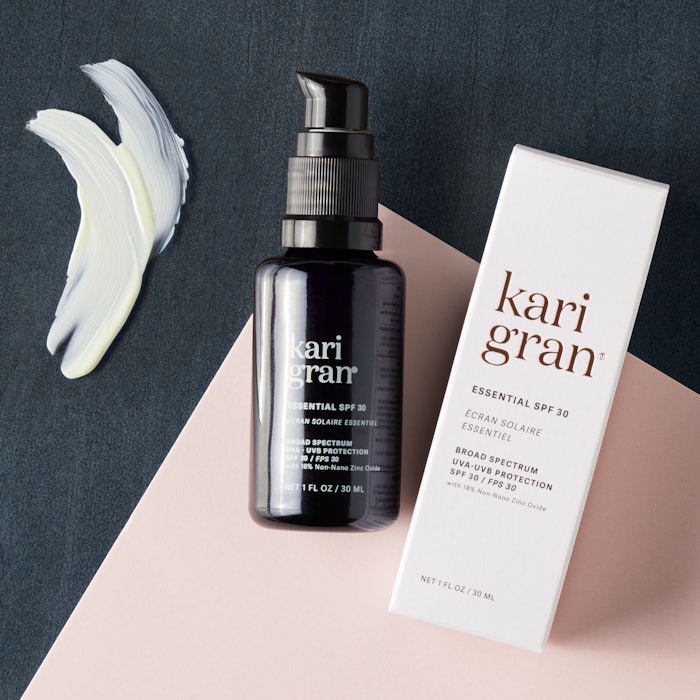
When we started Kari Gran in 2011, we didn’t really know what sustainability was. We were just trying to create products that wouldn’t harm ourselves or the environment. Lisa (my partner) and I were both born and raised in the Seattle area, which started municipal recycling well over 30 years ago, so that practice was already baked into our daily life. When we began our second career in beauty, we had the mindset that we were done following industry rules and traditions that didn’t make sense. When you’re not a spring chicken anymore, it’s easier to buck the status quo.
Our own personal north star of sustainability turned us into somewhat of pioneers in the clean beauty movement. Dumb luck worked in our favor as eco-consciousness began gaining momentum. Studies began to confirm what we knew in our gut—consumers are willing to change their shopping habits to be more environmentally conscious. And, it’s not just the young; sustainability is something that all age demographics are paying attention to. I would argue that we oldsters have more discretionary income and time to be more mindful of our choices. And that there is enough guilt to go around about the poor choices we have made personally and as a society that we should all be spurred to action.
So for companies who have always embraced sustainability, how do you stand out in the crowd and rise above those who are using it only for short-term gain (aka bandwagoners) until the next trend comes along to jump on? Let’s dig in.
Is Sustainability a Priority?
First, let’s focus on you. Is sustainability a part of your company’s ethos? Are your efforts only for customers and marketing? How are you addressing sustainability in your production and shipping facilities and at your business headquarters? What about socially— are you living by what you are preaching?
Sustainability is a long-term value and your customers will know if you are faking it. With authentic sustainability marketing you aren’t just pushing your newest serum, you are creating loyalty by inviting customers to be a part of your mission, and to believe in your business. And sometimes this means making hard decisions.
When we were a younger brand, we were brought the opportunity to sell our Lip Whips in Anthropologie. We were so psyched! Anthropologie seemed like such a good fit for us, and we loved their stores. Unfortunately, one of the requirements was all products had to be placed into individual plastic bags for shipment and distribution from their warehouses. We were shocked. Our products already came in boxes and were packed tightly, why did we need plastic bags? We tried to talk with the retailer, but they had a hard rule on this and wouldn’t budge. So, we walked away. We put sustainability over profit. It was hard (believe me) but Lisa and I both agreed that our soul was worth more.
If you’re still in the dabbling stage, take time to create your sustainability mission and how your brand works into this mission, and stick to it. You can use this as a framework for all your marketing efforts going forward.
Be Transparent
Own what you are doing and what you aren’t doing. At Kari Gran, a core value of our sustainability mission is progress, not perfection. We are on this journey with our customers and are constantly learning and trying to better ourselves. This has allowed us to gain trust with them. They applaud us (we call them atta girls) when we have wins, and give us inspiration when we struggle to find a solution.
We stay away from plastic in our packaging wherever there are alternatives. But, based on our small size and MOQs, this can be almost impossible. An example of this is our makeup line. Kari has searched for years for a new component, but they are either grossly cost-prohibitive or not a right fit for the ingredients. So we made 100% compostable refillable packets so that customers can reuse the makeup containers. We were honest with our customers about the frustration with sourcing but also that we kept pushing forward and found an alternative. It wasn’t perfect but it was progress.
Make your customers part of your wins and misses. Tone down the marketing polish that larger companies can use and make yourself human with your customers. The more they associate with you, the more long-term loyalty they will have.
What Makes You Different?
Our industry is highly competitive, even in sustainable marketing. So, what makes your brand different? What is unique about what you are doing and how can you market this?
We promote a simple, oil-based skin care solution. We’ve never been about using traditional beauty fear-based tactics with our customers, finger-wagging or portraying perfection. We also don’t push newness as a marketing tactic. So what do we do? We tell customers our products are multi-functional, waterless and a little goes a long way. Seems counterintuitive as we still need to sell products but we’re open about what we are and are not, and we’re working to build trust to increase loyalty.
Embrace what makes your brand unique and tell your customers about it. Everything from how you make products, to how you ship, to the efforts you are doing outside the day-to-day. All this is wrapped into the products you are selling. For many of us small, indie brands, our products are a reflection of our hard work and beliefs. Use them all to your advantage.
Make it A Part of All Your Marketing Efforts
You and your customers are together on this sustainability journey. A key is to make it a part of your brand vs utilizing it when convenient. From your first touch point to post-purchase, are you continually educating your customer along the journey?
Now, this doesn’t mean hitting your customer over the head with everything all the time. Figure out what content mix works best for you across all channels. This mix can include product, promotion, mission, and educational content. And through testing, see what mix works best for your brand. Social is the easiest as you can share a range of content easily and quickly, testing to see how it resonates with different groups. Email, on the other hand, might need to be more product-focused.
Be proud and shout it from the rooftops. A consistent marketing message across all platforms creates an authentic tone (and also makes it easier to build an editorial calendar).
So, my best advice is to drill down into all the little things you do and share your accomplishments and your faults–or, to use the business-friendly term, “opportunities.” For those companies who are truly embracing sustainability, customers will see this and ultimately vote with their dollars. Share your journey with your customers, they will love you for it.










